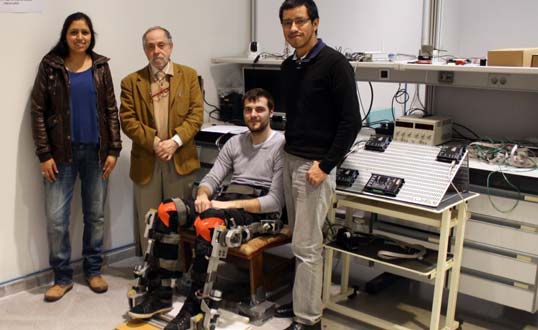Yesterday, I found this news: “They show a prototype of exoskeleton, that will replace wheelchairs”. And, this news makes me feel so good, because, since many years ago, I have heard about people who live in the Paraplegic Hospital of Toledo (South of Madrid, Spain). Many times, I could watch, on tv, how they fight, in order to recover themselves, with their rehabilitation.
But, now, with this prototype, all the patients, who use a wheelchair, will can move without it themselves.
The news explained the following: An exoskeleton, that is, still, in prototype stage, in the future could allow people, with some form of muscular or paraplegic atrophy, can move.
Designed by researchers from the group of Neurotechnology, Control and Robotics (Neurocor) of the Polytechnic University of Cartagena (UPCT), the prototype is the first step of Exo-legs (exoskeleton legs for Elder people) project, which involved UPCT, with researchers from Sweden, UK, Switzerland and Germany, reports the university.

Daniela Miranda, Juan Lopez, Antonio Hernández y Carlos Alberto Diaz showing the ptototype of exoskeleton, at the UPCT
The responsible investigator, Juan López Coronado, explains that it is the prototype of a first basic model.
This new design allows the elderly, with some type of muscular atrophy or disability, can perform actions, like scrolling motion, sit, stand up or climb and go down stairs.
This is a first step, towards the standard device, that will offer the opportunity to perform movements, in three dimensions, and even play sports, such as tai chi or skiing.
"We want it to be the substitute for cane or crutches, that currently use older people. Even it improves the performance of mobility, with health benefits, regarding wheelchairs”, explains Carlos Alberto Díaz, researcher of the Neurocor group.
The UPCT will test the prototype, at the National Hospital for Paraplegics, in Toledo, and in the nursing home “San Jose and San Enrique” of the town of Cieza (Murcia), have pointed Jorge Luis Feliu and José Muñoz, researchers of Neurocor.
The Exo-legs project is a European research program, in which three universities and five companies, health centres, specialized in paraplegia or disabled persons with reduced mobility.
In recent weeks, the researcher from Britain, Daniela Miranda, has worked with researchers of the UPCT, in implementing models, from a computer simulation.
It has a budget of over 4.5 million euros and its responsible is Gurvinden Virk, from the University of Gävle (Sweden). The UPTC has been received, concretely, 392,490 euros.
Well, I hope that they can develop this prototype and are able to take it out to market, in order to help many people.
Until my next post, kind regards,
Luis.
Sponsored by Costaluz Lawyers.
Please click below:
